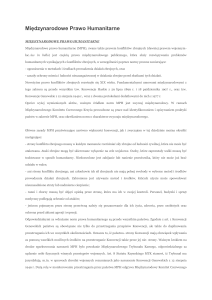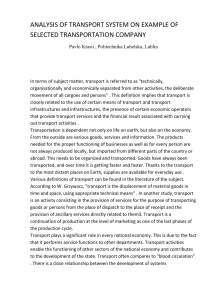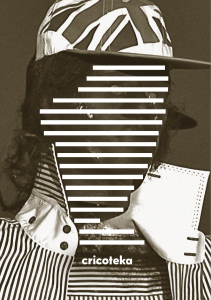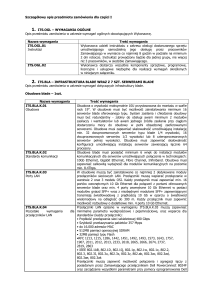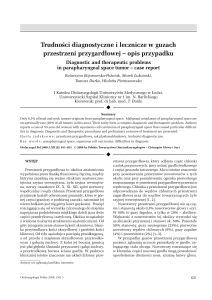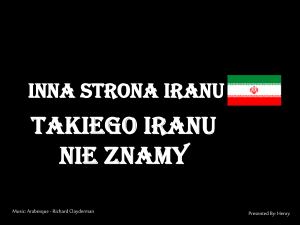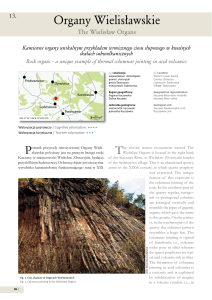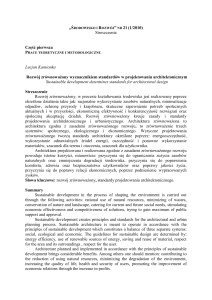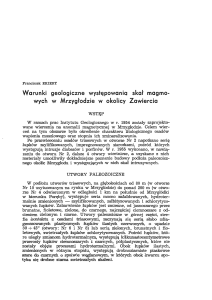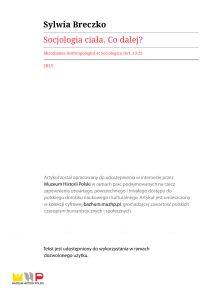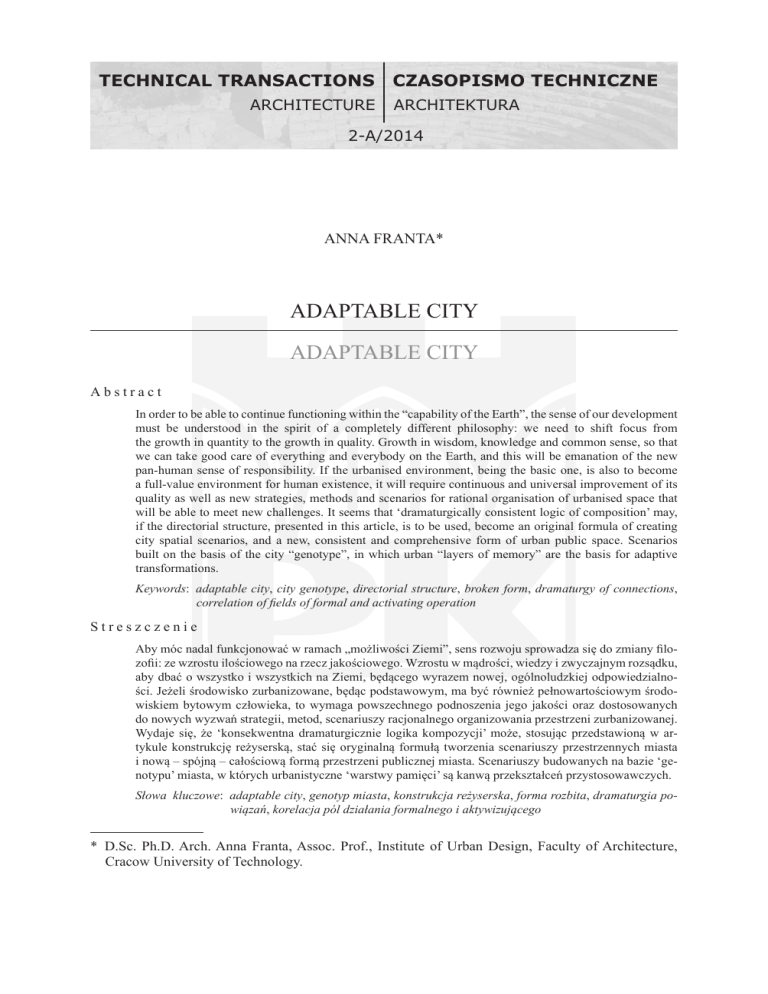
TECHNICAL TRANSACTIONS
ARCHITECTURE
CZASOPISMO TECHNICZNE
ARCHITEKTURA
2-A/2014
ANNA FRANTA*
ADAPTABLE CITY
ADAPTABLE CITY
Abstract
In order to be able to continue functioning within the “capability of the Earth”, the sense of our development
must be understood in the spirit of a completely different philosophy: we need to shift focus from
the growth in quantity to the growth in quality. Growth in wisdom, knowledge and common sense, so that
we can take good care of everything and everybody on the Earth, and this will be emanation of the new
pan-human sense of responsibility. If the urbanised environment, being the basic one, is also to become
a full-value environment for human existence, it will require continuous and universal improvement of its
quality as well as new strategies, methods and scenarios for rational organisation of urbanised space that
will be able to meet new challenges. It seems that ‘dramaturgically consistent logic of composition’ may,
if the directorial structure, presented in this article, is to be used, become an original formula of creating
city spatial scenarios, and a new, consistent and comprehensive form of urban public space. Scenarios
built on the basis of the city “genotype”, in which urban “layers of memory” are the basis for adaptive
transformations.
Keywords: adaptable city, city genotype, directorial structure, broken form, dramaturgy of connections,
correlation of fields of formal and activating operation
Streszczenie
Aby móc nadal funkcjonować w ramach „możliwości Ziemi”, sens rozwoju sprowadza się do zmiany filozofii: ze wzrostu ilościowego na rzecz jakościowego. Wzrostu w mądrości, wiedzy i zwyczajnym rozsądku,
aby dbać o wszystko i wszystkich na Ziemi, będącego wyrazem nowej, ogólnoludzkiej odpowiedzialności. Jeżeli środowisko zurbanizowane, będąc podstawowym, ma być również pełnowartościowym środowiskiem bytowym człowieka, to wymaga powszechnego podnoszenia jego jakości oraz dostosowanych
do nowych wyzwań strategii, metod, scenariuszy racjonalnego organizowania przestrzeni zurbanizowanej.
Wydaje się, że ‘konsekwentna dramaturgicznie logika kompozycji’ może, stosując przedstawioną w artykule konstrukcję reżyserską, stać się oryginalną formułą tworzenia scenariuszy przestrzennych miasta
i nową ‒ spójną ‒ całościową formą przestrzeni publicznej miasta. Scenariuszy budowanych na bazie ‘genotypu’ miasta, w których urbanistyczne ‘warstwy pamięci’ są kanwą przekształceń przystosowawczych.
Słowa kluczowe: adaptable city, genotyp miasta, konstrukcja reżyserska, forma rozbita, dramaturgia powiązań, korelacja pól działania formalnego i aktywizującego
* D.Sc. Ph.D. Arch. Anna Franta, Assoc. Prof., Institute of Urban Design, Faculty of Architecture,
Cracow University of Technology.
82
When we consider the future of cities and the cities of the future, it seems necessary
to bring to attention the apparently obvious statements which are, nevertheless, worth
repeating, since the quality of the space that surrounds us and of its management, which will
determine our future, is still unsatisfactory both in its local and global dimensions.
Global space – both natural and cultural – is the greatest good belonging to the human
community. The said community has therefore the right and responsibility to protect it wisely
and in solidarity from wasteful exploitation. The postulate of public utility of this good must
also presume such mutual conditioning of the rights and obligations of private owners that
would minimise the chance of their infringement of collective interests.
In order to be able to continue functioning within the “capability of the Earth” – given
the UN prognosis that by 2050 mankind will have reached the number of 9 billion –
the sense of our development must be understood in the spirit of a completely different
philosophy: we need to shift focus from the growth in quantity to the growth in quality.
Growth in wisdom, knowledge and common sense, so that we can take good care
of everything and everybody on the Earth, and this will be emanation of the new pan-human sense of responsibility.
The culture of space management became an important measure of cultural level
of societies at the turn of the 20th and 21st centuries, perhaps one of those moments which
decide upon the future of our civilisation. Some of the wounds inflicted by man on nature are
irreversible. Human civilisation is able to destroy free goods, but even the most cutting-edge
technology is unable to recreate them. We have limited power of restoration of what we have
not created ourselves but what has been given to us instead. The postulate for reform refers
first of all to what we have created: areas that have already been urbanised. The conclusion
that large agglomerations in particular are ‘incorrigible zones of spatial and social pathology,
from which we need to escape into pristine areas and there create a more perfect living
environment’ is unacceptable, also from the ethical point of view, both as regards the people
living in those agglomerations and to nature. As far as what has been created by man
is concerned, we need to assume that we are able to control and improve this material
creation of our civilisation. Such is the fundamental requirement of sustainable development
– a difficult, but probably the only way of managing ‘the global village’ in the millennium
that has just commenced. “The complete renewal and transformation of the architectural
image of the surrounding world seems necessary today, and today it is still possible. It may
be done only by a new spatial ‘poetics’, restoring sense and dignity to the place of each man
individually and at the same time of the whole humanity on this planet here, vandalised
and threatened with destruction, but still alive”1.
To think as mankind – this is a new global task, set for the first time in history. It entails
questioning the attitude of dominance – conquering and exploitation of Nature by man,
which should give way to the attitude of care: collective and united not only in the face
of challenges but also in looking for solutions. We have found ourselves at the moment
M. Porębski, Ikonosfera, PIW, Warsaw, 1972, p. 169. More than 40 years have passed since these
words were written, and the renewal now seems all the more necessary (the awareness of which
is growing) and possible, the proof of which may be found in positive examples implemented
in architecturally and environmentally ‘mature’ countries, cities and places.
1
83
of key importance: the time of REPAIR of what has been destroyed or distorted, but can still
be repaired, recreated or restored to the state of equilibrium.
Destroying nature, man has triggered the process of self-destruction, which is now
in progress. By mutilating landscapes in which nature is united with culture, on the one
hand humans annihilate their own past constituting their identity, and on the other they put
their future at hazard, crush and blur their national, regional and local individuality. So they
mutilate themselves2. Space and its quality is – as the natural, cultural and civilizational
good – a common value and property (at every level: local, regional, national or global) –
it belongs to everybody.
Although an urban and architectural space is often created ‘for’ and ‘on commission by’
a specific client-investor, it lasts considerably longer than one man’s lifetime. Its recipientuser of the more distant future is always anonymous. Common (and independent from social
and economic status) accessibility of public spaces of the city makes everybody who enters3
them anonymous as ‘a user’, yet they are not anonymous in the sense that they are human
beings whose needs should be catered for by these spaces to the possibly fullest extent. City
public spaces have the tradition of ‘stone books’, records of the social organisation, hierarchy,
culture and lifestyle of the place. Records addressed on the one hand to the present: providing
information and facilitating orientation by the manner in which the structure is organised,
but on the other hand they are directed towards the future: a permanent evidence of what the
city – as the unity of spatial and social structures – used to be and is now. Understood as such,
it is the common good of the past, present and future generations.
From the social point of view, the ethical minimum standard is a public space that
is safe and organised in the way preventing creation of ‘economic ghettoes’. Mixing users4
of different social and economic status in the same neighbourhood and in the same street
promotes democratic ‘normalcy’ of social contacts and relations – normalcy expected
in any society with aspirations of a mature democracy. Such is the purpose public space
ought to serve as a continuum: attractive, safe, promoting contact, stretching through
and linking city parts of different character and standard. This is the basis for natural
creation of – simultaneously – spatial and social identity. Identity whose protection and
development must be treated as an ethical requirement (imposed both on individuals and
communities).
From the social-cultural point of view, the quality of public space could be interpreted
as its ‘communication capability’, i.e. the ability to facilitate emergence of interaction: space
to space, human to human and human to human through space. Communication capability
of public space is on the one hand the broadcast of the ‘face’ of the city, and on the other
– an inspiration for interaction ‘in’ and ‘with’ space, promoting safety and comfort, first
See: P. Saint Marc, Przyroda dla człowieka, PIW, Warsaw 1979. Space is for humans not only
a biological need, as is the case of the whole animal kingdom, but also a need of psychological
nature. Having a territory at one’s disposal means possessing one of the most essential components
of life, not having it is one of the most serious threats to life.
3
The ‘entry’ refers both to the physical presence and making use of a given space and to the exclusively
visual contact with it.
4
And structures of different standards corresponding to their requirements (or financial means) – from
good, trough medium up to luxurious, but not sub-standard.
2
84
of all in the psychological dimension (friendly space). It seems that the quality of public
space in this communicative aspect is decided by the correct relation between the spatial
form and functional filling, or in other words – efficient connections between the fields
of formal operation and the fields of operation proper – this ‘social and cultural’ dynamics
which is the essence of what Rogers calls ‘civic beauty’ of public space.
Social significance of public space in a way exerts its necessary quality: from
the commonly encountered ‘sufficiently good’ to exquisite, unique. Quality understood
in this way is a factor generating economic success and a condition of long-term social and
cultural success, which is also directly translatable into the benefit of minimising social costs5.
The space mankind living on the Earth has at their disposal – a limited free and common
good – is getting progressively ‘filled’ as a result of human presence and activity. Hence,
irrational management of space – both natural and anthropogenic – space without any order,
space hostile to human psychic are an equally serious threat to our existence on the Earth
as contamination of water, atmosphere and soil. The only factor which may enforce order,
understood as rational management, is the ‘limited availability of space’ in the global scale,
and the following limitations for the expansion of anthropogenic environment – including
urbanised areas – protecting the maximum of Earth space first of all for nature.
What we now label with the term of anthropogenic environment has been created
in the course of the civilizational development by generations of humans “step by step
trying to bestow form upon their whole surroundings”6, unfortunately, not always the most
adequate form. Humans, being creatures of incredible adaptation capabilities, can endure,
accept and adapt to extremely difficult conditions, yet it does not mean that such conditions
are appropriate for life and development.
If the urbanised environment, being the basic one, is also to become a full-value
environment for human existence, it will require continuous and universal improvement
of its quality as well as new strategies, methods and scenarios for rational organisation
of urbanised space that will be able to meet new challenges.
Its ever-present problems are: occupying too much space for no justifiable reason,
inadequate use of spaces (as a rule, the only criterion that is applied is the one of suitability
of a place for a specific function, while the criterion of optimum functionality for a given
place, so important from the point of view of social interest, is disregarded) and spoiling
the beauty of valuable complexes or their unwise annihilation (destruction entailed by
contemporary wars and uncontrolled invasion of aggressive advertising into the most
valuable old town centres may be seen as the new faces of ‘cultural barbarism’). They are
reflected in the disorderly, dehumanised and ‘denaturalised’ (P. Saint Marc), ‘hostile’ and
chaotic spatial from, particularly in huge agglomerations. It seems sensible to ask ourselves
whether this aesthetic contamination is not somehow linked in a cause-effect relation to the
ethical contamination, described by Stanisław Lem as social environment pollution with
villainy, passivity, cruelty, cynicism and egoism – moral and ethical relativism, more and
more commonly accepted in the society.
Social costs are in turn generated by low quality of living environment (its poor spatial, functional
and ecological condition); see: P. Saint Marc, op. cit.
6
S.E. Rasmussen, Experiencing Architecture, MIT Press, 1992, p. 34.
5
85
At the same time, instability and fluctuations creating order out of chaos are
spreading and now engulfing a broad spectrum of social sciences. They give hope
since, even if small, they can change the structure of the whole, trigger the mechanism
of structure-making and order creation (I. Prigogine). There is an inherent striving for
equilibrium in nature. Absence of equilibrium releases the energy (need) to make order:
striving for a different equilibrium, in the continuum of subsequent cycles sequenced
in time – irreversibility. “Out of chaos comes order, the order of necessity, the unity
of the moment, when the immensity of matter takes its final form and calls its name”
(J. Tuwim).
Theatre is the art of integrating components from different fields into a new synergic
whole. With architecture the situation is similar. In theatre and in architecture we always
talk about ‘the form of space’ in its broadest sense and about the process of human actions
– filling it, making it ‘come alive’ and bestowing sense upon it. We direct the space,
deciding on its condition – what it ‘looks like’ and ‘how it behaves’. We direct its users,
with the use of the space, through space and its condition, we influence human reactions,
actions and interactions. Knowledge leads to awareness (insight – inspection – opinion),
and the latter to responsibility. Each new action in the anthropogenic space – particularly
in the public space of the city – is a directorial action: changes the state of things,
simultaneously inducing an effect at the recipient. A special sense of responsibility
is necessary here – for the quality of change: does it entail values (positive change)
or deteriorate the state of things? The skill of tuning into the stream of the already existing
directorial thought – operating in the arrangement (including formal guidelines as its
components) – seems indispensable. Sometimes the said thought is ‘natural,’ sometimes –
consciously planned, sometimes – a combination of the two. Directing space assumes that
the arrangement is dynamic. It appreciates, respects and applies (takes into account) both
‘laws’ and ‘principles’ on the one hand and improvisation on the other, determinism and
‘necessity’, but also ‘accidentality’. In its essence it is interdisciplinary in approach and
interactive.
In general, the directorial structure is a compositional and coordinating skeleton
of the whole with some provided margins of flexibility (changeability, improvisation,
modification), which do not distort (destroy, violate) the idea of the whole. Its quality
is founded on what is permanent – belonging to the skeleton – but with a consciously
designed and admitted margin of interference which may influence the quality (but may not
sink it below the level maintained by the said skeleton).
That is precisely the reason why the word ‘directing’ is used to indicate exerting
influence over the form of the urban and architectural space, because the following two
features of a directed piece are important: controlling the whole and providing a margin
of flexibility – improvisation and openness – which does not threaten the quality
of the whole.
The directorial structure (directorial skeleton) as regards the city may be treated
as a coordinated system of accessibility (public space of the city accessible for various
actions, including its movement) and a system of communication (the language of signs
of urban and architectural space, including its form, providing intellectual and emotional
information on the possibilities resulting from contact with it). In other words: it is a structure
86
crystallising the image of the city in reception7. An important role in this structure is played
by the relation between the form and the content in the meaning of organising the fields
of formal operation and the fields of activating operation.
The field of formal operation is related to the form and its interaction with the surrounding
space (including other forms) – it is related to the subject.
The field of activating operation (‘the field of activity’, ‘the field of behaviours’) pertains
to the functions (the admissible range thereof) in relation to the structure of the form. As it
pertains to the ability to stimulate certain social interactions (of certain predictable regularity,
intensity, popularity and generality) – it is related to the process.
The value of the composition is determined by its order, understood as a non-antagonistic
relation between the fields of formal operation of the forms – elements of the composition,
their synergic cooperation: “the play with architectural forms consists in organising the fields
of formal operation” (J. Żórawski). The above statement – fundamental for the ‘directorial
structure’ – is derived from the interactions between the form and the background (the form
exerts influence on the background-surroundings, and the background-surroundings on
the form, modifying each other in perception) and between the form and the form8.
‘Controlling’ the background – the area surrounding the form and constituting its field of
formal operation is an integral part of the compositional task. It is a prediction, ‘optimisation’
of the form reception, necessary for the ‘quality of the form in reception’ as well as an
objective substantiation of the validity of directorial control over whole sequences of the city
public space.
Synergic – mutually adding to each other’s value – composition of the fields of formal
operation of the forms – parts creating an arrangement, reinforces the field of operation
of the whole arrangement, bestows upon it the predispositions of an element of spatial
crystallisation.
A certain structure of form influences the field of activating operation and its potential
dynamics. In the same spatial complex with a specific (stable – as a rule) arrangement
of fields of formal operation, the arrangement of fields of activating operation is changeable
Kazimierz Wejchert’s analysis of ‘the curve of impressions’ and the system of crystallisation – ‘elements
crystallising the plan’ – were an inspiration for the directorial approach, which was the subject
of the author’s habilitation dissertation (see: A. Franta, Reżyseria przestrzeni. O doskonaleniu
przestrzeni publicznej miasta, Monograph 309, CUT Press, Kraków 2004) here presented synthetically.
The concept of the directorial structure is broader in scope and strives to encompass not the ‘subject’
alone, but the ‘subject in the process’ – the spatial environment together with the human environment
active within; see: K. Wejchert, Elementy kompozycji urbanistycznej, Arkady, Warsaw 1974 and
Elementy krystalizujące plan i inne teorie kształtowania środowiska człowieka, [in:] Problemy teorii
architektury w świetle współczesnej praktyki, SARP, Katowice 1980.
8
It seems relevant here to invoke Juliusz Żórawski’s conclusions drawn from his reflections upon
the structure of an architectural form: “Each whole creates a form and each form is a whole.
The form is not a sum of parts, it is something more. The form depends on the relation between parts
and the whole. The form is a unity of many variables. The form, once it becomes a part of a bigger
whole, loses its individuality in favour of this whole. The form depends on the whole in which
it is to appear. The form, when it changes, brings about the change of the whole of which it is a part
as well as the change of all the other parts of which this whole is composed”, J. Żórawski, O budowie
formy architektonicznej, Arkady, Warszawa 1973, p. 116.
7
87
but subjected to the conditions determined by the form. It depends on the flexibility
of the structure of the form – on its ‘openness’ towards accepting a certain range of functions
and associated processes as well as of the ways in which this flexibility is to be used.
Synergic composition of the fields of activating operation within a given spatial
complex reinforces the field of activating operation of the whole complex, bestows upon
it the predispositions of an element of activating crystallisation (hubs of activity, arteries
of activity, ‘bridges’ of activity allowing users to overcome ‘barriers’ in the city space and
to reconnect its parts separated by the said barriers).
We can also achieve synergic cooperation in the interaction between the two types
of fields: the field of formal operation and the field of activating operation – a mutual positive
reinforcement. A discord is also possible in a situation of ‘conflict’ – formal and activating
discrepancy. Neutrality is a potentially positive situation, i.e. it opens up the possibility
of cooperation.
Compositional combination of these two types of fields defines ‘what for’ and ‘how’ city
public spaces work in relation with the recipient, because it depends on ‘what’ is in them
and ‘how’ they are composed. Optimum combination of these fields means that the content
has found its expression in the most adequate correlation of forms creating an arrangement
of ‘double synergy’: both in shape and in significance.
The physical space of a work of architecture is its shape and mode of existence in a three
dimensional space. It manifests itself to the recipient as a ‘visual’ space, but also ‘tactile’,
‘auditory’ and ‘kinetic’ – all at once. This external space allows the recipients – owing to its
formative features – to understand ‘their individual’ place in this space – specific to their own
way of ‘using’ the space, not only functional but also ‘intellectual’ and ‘emotional’.
The space of significance of a work of architecture is its reception and understanding
– the existence in the internal, intellectual and emotional, space of the recipient, in their
“field of internal state” (J. Żórawski). In this space – in the changing field of internal state
– all the people and places ever encountered leave their traces, all the modes of time are
contained within: the past, the present and the future. At the same time, it is the space
of images (creative, future-oriented transformations of what has been experienced and
is now familiar), the memory space of sensations in the broadest sense, and illumination:
clarity of ‘significances’ manifesting themselves in pictures. This field is finally decisive
for ‘how’ we see the world, but at the same time its condition (quality, richness) depends
on ‘what’ we see in the theatre of our lives.
The directorial skeleton is a ‘closed structure’ of sequences, which means that it entails
reaching the image of the whole by operating its ‘finite’ fragments in order to achieve clarity
of composition at every stage of creation of the said whole.
Dramaturgy of associations is the immanent feature of directorial thinking.
In the directorial structure, the shape and logic of individual scenes-sequences are justified
by the subsequent ones, while at the same time the significance of each of them is gradually
revealed: first at the moment when it is perceived and then in the context of the whole,
i.e. its role in this whole.
In a good theatrical production, each scene is a whole in itself, while at the same time
it belongs to and co-creates the whole of the production, making the necessary references:
it is the consequence of the previous scene and the opening for the next one.
88
The public space in the city is, at least potentially, such production. At the present
condition of space, we are able to see good or splendid productions only exceptionally, but
they prove the validity of the above thesis. The reflections here are intended to serve the
purpose of promoting the process of turning public spaces into ‘good productions’.
At this point let us turn to nature as the model of harmony, sustainability and logic.
An ‘organism’ is by definition a ‘living creature, a corporeal system,’ but at the same time –
‘a complex of parts creating a whole, a structure’.
Let us view the organism as a living creature.
Every element (cell, organ) has its own form and task in an organism, they contribute to the
form of the whole and co-decide on its functioning. The form is a sign, information on ‘good
genes’ and fertility. It attracts partners of different (complementary) genes, which increases
the quality of offspring. The elements replace each other, continue, change and improve
the whole understood as the continuum through generations, coordinated by the genetic
code. This code, ensuring that the organism develops in compliance with its own internal
rules, is like a structural skeleton: a clear arrangement – repetitive in the scale of a species,
yet allowing modifications deciding upon the uniqueness and inimitable character of each
individual.
They are mechanisms of self-perfection, ‘encoded’ in the organism and expressed through
its form. The body architecture of a living creature is optimally adjusted to the principles
of its functioning in the environment, its co-dependencies and priorities. The body agrees
to – accepts as if of its own accord – what is beneficial for it. Unfortunately, it sometimes
also opens to the things that destroy and kill it. What counts in the defence of the body –
ensuring its correct functioning and development – are alertness (to recognise the dangers),
information and, obviously, coordination of actions.
Let us now consider the ‘organism’ in the second meaning, as a complex of parts
creating a whole, a structure – a living space for humans and created by humans, i.e. the city.
Development – transformations – interchangeability (of function, form, users) are the essence
of this organism, so are conditions and rules understood as the ‘genotype’ of the process
of its transformations. The saying: ‘life has got the last word’ may be interpreted as an argument
against coordinated and planned actions, as it suggests that ‘anyway, people always prevail
over those who plan,’ and the heritage of the past will always bend – and it will always be
bent – to the needs of the future life. But it could be assumed that it is precisely for this reason
that the effects of ‘predicting’, ‘flexibility’ and ‘respect for the existing conditions’ which are
contained in the planned actions – all the things that are so important in directing, including
space directing – are absolutely essential. The issue is not whether ‘people will prevail over
planners’ or ‘planners will prevail over people’, but that programming (directing) actions,
efficiently recognising and predicting the needs of the community, should serve the purpose
of improving the quality of (perfecting) the anthropogenic environment.
Nature has the ability to regulate itself and to do it with the use of optimum measures.
In the case of human activity, it is necessary to be aware that regulation is indispensable
and to work out the optimum ways of its implementation. It is important to ‘tune in’ with
the guidelines already built into the arrangement and to provide their creative development
in a highly competent way, efficiently and with the sensitivity allowing extracting and
passing on this ‘good gene’ of urban composition and architectural features, as well as to
89
select new ‘formal genes’ beneficial for the proper development of this particular organism’s
identity. What follows is not focusing on repeating the same patterns (even the well tested
ones), but logical modification derived from introducing and promoting patterns improving
the quality and appeal of the space in compliance with the ‘identity guideline’, and avoiding
(thanks to protective regulations) harmful and unifying patterns that are not compliant with
this guideline.
Good continuation is innovation appreciating tradition and open to dialogue, i.e. listening
to what the existing arrangement has to communicate and formulating an answer, according
to the rule of interaction: sending information, processing it (understanding, interpreting) and
reacting precisely to this information.
Order is created in compliance with the general principle of natural order: similar things
require to be linked and different things to be separated. At the same time, however, the detailed
principles of high culture must also be obeyed, and they are: levelling and complementariness.
The principle of levelling indicates the necessity of creating connections with higher levels,
of which a given task is a component, and simultaneously with lower levels, which it contains
– i.e. vertical, hierarchical consistency. At the same time, the same principle recommends
considering a task in the context of its connections with other tasks at the same level, i.e. horizontal
(neighbouring) consistency. This vertical and horizontal coordination ensures continuity (and
logic) in the space and encourages elimination of conflict decisions9, since both components serve
each other and promote high quality of solutions. The essence of complementariness is mutual
supplementing and conditioning of elements in their cooperation, which allows co-creation and
achieving values (solutions) that would be impossible to achieve without the parallel existence
of those several components. It entails non-antagonistic cooperation of different things and
composing sequences, unique or imitative, which complement the composition with a new
value (hitherto absent or missing but desired or needed).
In contemporary architecture and urban design, which encompass the whole historic
heritage of the art of city building and the legacy of theoretical thought until the present
time, there are many different formal trends which are not alternative to each other but
complementary (such as, which is clearly discernible, the arrangement of the ‘acropolis’
type and the arrangement of the ‘forum’ type). It seems that particularly from the presented
directorial point of view, oriented towards perfection, there is no formal trend that would
be in any way ‘superior’ to others. The decisive factor is the ‘suitability’ for a given task,
given place and given conditions. It is possible to create magnificent, surprising, exceptional,
unique and logically composed arrangements from those different potential formal trends,
and such arrangements have been created. However, what happens all too often in city public
spaces is mutilated arrangements (which have never obtained the intended compositional
form or have lost this form) and arrangements that are compositionally ignorant10; in effect
they produce the condition in which certain fragments of public space lack any composition.
Hence the need of coordination of both these elements as the fundamental requirement in planning
control (regulation) over spatial development – as confronted with the requirement of its sustainability.
10
Ignorant, i.e. defying the principles of composition; they should be distinguished from ‘picturesque’
arrangements, which perhaps have not been controlled by one compositional concept, but which
‘intuitively’, subconsciously complied with the natural principles of composition, the effect of which
is the condition of free (picturesque) composition of the arrangement.
9
90
The spatial structure of the contemporary city as a whole is a ‘broken form’: it has
formally expressive and perfectly composed elements, it has mutilated compositions, chaotic
arrangements and ‘lost spaces’11, finally, it has spaces that as yet have not been properly used
compositionally and are still waiting for their ‘role’ in the whole.
A broken form – in compliance with the principle of irreversibility – may not return
to its original composition. Thinking about the future of the city and taking into account
the irrefutable fact that a considerable part of the built environment of tomorrow already
exists today, we should ask ourselves the question: can it adopt, as a whole, a composition
of a different kind?
Let us once again turn to the theatre so that we can follow the path of thought leading
to building a new creative and open form out of the ‘broken form.’ Tadeusz Różewicz
– in his plays the theatrical space is of great importance – created a new quality both
in terms of dramaturgical structure and theatrical form: he used the ‘broken form’ of reality
and the theatrical tradition. “I have been safeguarded by my foresight (…). I said that
the only way out was to make ourselves independent from form. And as everybody knows,
it is impossible to be free from form at all. Neither in art, nor in biology, nowhere (…).
So it was a paradox. But this paradox offered a way out”12. The theatre of Różewicz –
‘the theatre of inconsistency’, ‘the theatre of impure form’ is an exceptionally consistent,
perfectly dramaturgically constructed and composed collage. A collage in which diverse (and
‘of different value’ as material) dramaturgical matter constitutes and crystallises into a new
sense, a new play. It is not negation of the reality or throwing away traditional conventions
into the ‘culture’s garbage dump.’ It is constant revision of the reality and cultural heritage
allowing creation of his own vision. “Form becomes content, and content becomes form”
(T. Różewicz). The form fills up with content and the content generates form. Traditional
conventions – the rules of communication with the viewer – have been used anew: they
return in a new form, as a new value and quality. The chaos of diverse ‘dramatic material’
(often at shocking discord with each other) composed in the dramaturgically consistent logic
of composition creates order. The essence of plastic arts collage transformed brilliantly
into the language of theatre has created a new original formula of drama and a new
comprehensively consistent theatrical form.
It seems that such ’dramaturgically consistent logic of composition’ may, if translated
in turn into the language of urban and architectural space and if the presented directorial
structure is to be used, become an original formula of creating city spatial scenarios, and
a new, consistent and comprehensive form of urban public space. Scenarios built on the basis
of the city “genotype,” in which urban “layers of memory” are the basis for adaptive
transformations. May the answer to the problem posed by the 2013 edition of the international
competition EUROPAN: ADAPTABLE CITY, presented below, be an illustration of such way
of thinking.
Lost space – see: R. Trancik, Finding Lost Space: Theories of Urban Design, Van Nostrand Reinhold,
New York 1986.
12
K. Braun, T. Różewicz, Języki teatru, Wydawnictwo Dolnośląskie, Wrocław 1989, p. 76.
11
91
Ill. 1. The presented version prepared for the competition is a part of the diploma project developed
at CUT Faculty of Architecture, in the academic year 2012/13. authors: Mateusz Bryk and
Piotr Gierek; supervisor: Anna Franta, DSc. PhD. Arch. Assoc., prof. of CUT; consultant for
the competition part: Michał Palej, MSc in architecture
Il. 1. Prezentowana wersja konkursowa jest częścią pracy dyplomowej wykonanej na WA PK w roku
akademickim 2012/2013: autorzy: Mateusz Bryk i Piotr Gierek; promotor: dr hab. inż. arch. Anna
Franta, prof. PK; konsultant części konkursowej: mgr inż. arch. Michał Palej
92
Ill. 2. The presented version prepared for the competition is a part of the diploma project developed
at CUT Faculty of Architecture, in the academic year 2012/13. authors: Mateusz Bryk and
Piotr Gierek; supervisor: Anna Franta, DSc. PhD. Arch. Assoc., prof. of CUT; consultant for
the competition part: Michał Palej, MSc in architecture
Il. 2. Prezentowana wersja konkursowa jest częścią pracy dyplomowej wykonanej na WA PK w roku
akademickim 2012/2013: autorzy: Mateusz Bryk i Piotr Gierek; promotor: dr hab. inż. arch. Anna
Franta, prof. PK; konsultant części konkursowej: mgr inż. arch. Michał Palej
93
Ill. 3. The presented version prepared for the competition is a part of the diploma project developed
at CUT Faculty of Architecture, in the academic year 2012/13. authors: Mateusz Bryk and
Piotr Gierek; supervisor: Anna Franta, DSc. PhD. Arch. Assoc., prof. of CUT; consultant for
the competition part: Michał Palej, MSc in architecture
Il. 3. Prezentowana wersja konkursowa jest częścią pracy dyplomowej wykonanej na WA PK w roku
akademickim 2012/2013: autorzy: Mateusz Bryk i Piotr Gierek; promotor: dr hab. inż. arch. Anna
Franta, prof. PK; konsultant części konkursowej: mgr inż. arch. Michał Palej
94
Podejmując rozważania nad przyszłością miast i miastami przyszłości wydaje się konieczne przywołanie stwierdzenia pozornie oczywistego, a jednak wartego powtórzenia,
że determinująca naszą przyszłość jakość otaczającej nas przestrzeni i gospodarowania nią
jest, w wymiarze lokalnym i globalnym, wciąż niewystarczająco wysoka.
Globalna przestrzeń – i naturalna, i kulturowa – jest największym dobrem należącym
do społeczności ludzkiej. Społeczność ta ma zatem prawo i obowiązek solidarnie i mądrze
chronić ją przed rabunkową gospodarką. Postulat użyteczności publicznej tego dobra musi
zakładać także takie wzajemne uwarunkowanie uprawnień i obligacji właścicieli prywatnych, które minimalizowałoby szansę naruszenia przez nich interesów zbiorowości.
Aby móc funkcjonować w ramach „możliwości Ziemi” – wobec prognoz ONZ, według
których w 2050 roku ludzkość osiągnie 9 miliardów – sens rozwoju sprowadza się do zmiany
filozofii: ze wzrostu ilościowego na rzecz jakościowego. Wzrostu w mądrości, wiedzy i zwyczajnym rozsądku, aby dbać o wszystko i wszystkich na Ziemi, będącego wyrazem nowej,
ogólnoludzkiej odpowiedzialności.
Kultura gospodarowania przestrzenią stała się istotnym miernikiem poziomu kulturalnego
społeczeństw na przełomie XX i XXI wieku, być może jednym z decydujących o przyszłości
naszej cywilizacji. Niektóre rany zadane naturze przez człowieka są nieodwracalne. Cywilizacja ludzka może niszczyć dobra wolne, ale nawet najdoskonalsze dostępne technologie nie
są w stanie ich odtworzyć. Nad tym, czego nie stworzyliśmy, co było nam dane, w zakresie
naprawy panujemy w sposób ograniczony. Postulat naprawy dotyczy przede wszystkim tego,
co stworzyliśmy: obszarów już zurbanizowanych. Akceptacja, szczególnie wielkich aglomeracji, jako ‘nienaprawialnych stref patologii przestrzennej i społecznej, z których trzeba
uciekać w obszary nieskażone i tam tworzyć doskonalsze środowisko zamieszkania’ jest
niedopuszczalna również z etycznego punktu widzenia i to zarówno w odniesieniu do ludzi
w nich żyjących, jak i do natury. W stosunku do tego, co stworzył człowiek, musimy zakładać, że potrafimy nad tym materialnym wytworem naszej cywilizacji zapanować i go doskonalić. To jest kardynalny wymóg rozwoju zrównoważonego: trudnej, ale prawdopodobnie
jedynej drogi gospodarowania w „globalnej wiosce” w rozpoczętym tysiącleciu. „Całkowite
odnowienie i przekształcenie architektonicznego obrazu otaczającego nas świata wydaje się
już dzisiaj konieczne i jeszcze dzisiaj możliwe. Może to zrobić tylko nowa przestrzenna ‘poetyka’, przywracająca sens i godność miejscu każdego człowieka i całej zarazem ludzkości,
na tej i tutaj zdewastowanej i zagrożonej, ale wciąż jeszcze żywej planecie”1.
Myśleć jako ludzkość – to nowe, po raz pierwszy w historii postawione globalne zadanie.
To podważenie postawy dominacji – podboju i eksploatacji Natury przez człowieka – na
rzecz troski: solidarnej, zjednoczonej nie tylko w wyzwaniach, ale w rozwiązaniach. Znaleźliśmy się w kluczowym momencie: czasie NAPRAWY tego, co zostało zniszczone, zachwiane, a co jeszcze da się naprawić, odtworzyć czy przywrócić do stanu równowagi.
Niszcząc przyrodę, człowiek wyzwolił narastający proces samozniszczenia. Okaleczając krajobrazy, w których przyroda zespala się z kulturą, wykreśla, z jednej strony swoją
M. Porębski, Ikonosfera, PIW, Warszawa 1972, s. 169. Po ponad 40 latach od napisania tych słów
wydaje się to być jeszcze bardziej konieczne (czego świadomość narasta) i wciąż możliwe, czego
dowodzą pozytywne przykłady realizowane w dojrzałych architektonicznie i środowiskowo krajach,
miastach, miejscach.
1
95
tożsamościową przeszłość, z drugiej zagraża przyszłości, kruszy, rozmywa swą osobowość
narodową, regionalną i lokalną. Okalecza, więc samego siebie2. Przestrzeń i jej jakość jest,
jako dobro naturalne, kulturowe i cywilizacyjne, wartością i własnością wspólną (na każdym
szczeblu: lokalnym, regionalnym, krajowym, światowym) – należy do wszystkich.
Przestrzeń urbanistyczno-architektoniczna, choć często powstaje dla i na zamówienie
konkretnego klienta-inwestora, trwa znacznie dłużej niż życie jednego człowieka. Jej odbiorca-użytkownik w bardziej odległej przyszłości jest zawsze anonimowy. Powszechna (oraz
niezależna od statusu społecznego i ekonomicznego) dostępność przestrzeni publicznej miasta sprawia, że każdy, kto w nią wkracza3, jest anonimowy jako korzystający, ale jednocześnie nie jest anonimowy jako osoba ludzka, której potrzeby przestrzeń ta powinna realizować
w sposób możliwie najpełniejszy. Przestrzeń publiczna miasta ma tradycję kamiennej księgi
zapisu organizacji społecznej, hierarchii, kultury, stylu życia. Zapisu adresowanego z jednej
strony do teraźniejszości: informującego i ułatwiającego orientację przez sposób zorganizowania struktury, ale z drugiej skierowanego ku przyszłości: trwałego świadectwa tego, czym
miasto jako jedność struktury przestrzennej i społecznej było i jest. Tak rozumiana przestrzeń
jest dobrem wspólnym przeszłych, teraźniejszych i przyszłych pokoleń.
Ze społecznego punktu widzenia etyczny standard minimum to przestrzeń publiczna bezpieczna i przeciwdziałająca tendencji tworzenia gett ekonomicznych. Przemieszanie użytkowników4 o różnym statusie społeczno-ekonomicznym w tej samej dzielnicy, na jednej
ulicy sprzyja demokratycznej normalności kontaktów i stosunków społecznych – normalności oczekiwanej w społeczeństwie o aspiracjach dojrzałej demokracji. Temu powinna służyć
przestrzeń publiczna jako continuum: atrakcyjne, bezpieczne, sprzyjające kontaktom, przebiegające poprzez oraz łączące fragmenty miasta o różnym charakterze i standardzie. To jest
baza naturalnego tworzenia jednocześnie tożsamości przestrzennej i społecznej. Tożsamości,
której ochronę i rozwój należy traktować jako wymóg etyczny (w stosunku do jednostki
i społeczności).
Ze społeczno-kulturowego punktu widzenia jakość przestrzeni publicznej można interpretować jako jej komunikatywność, czyli ułatwianie zaistnienia interakcji: przestrzeń–
człowiek, człowiek–człowiek i człowiek–człowiek poprzez przestrzeń. Komunikatywność
przestrzeni publicznej z jednej strony jest przekazem oblicza miasta, z drugiej inspiracją
do interakcji w i z przestrzenią, sprzyjając bezpieczeństwu i komfortowi, przede wszystkim
w wymiarze psychologicznym (przestrzeń przyjazna). Wydaje się, że o jakości przestrzeni publicznej, w takim komunikatywnym aspekcie, decyduje prawidłowa relacja pomiędzy
kształtem przestrzennym a wypełnieniem programowym, czyli inaczej skuteczne powiązanie pól działania formalnego z polami właściwej aktywności – owa społeczna i kulturowa
dynamika, która stanowi istotę tego, co Rogers nazywa civic beauty przestrzeni publicznej.
Por.: P. Saint Marc, Przyroda dla człowieka, PIW, Warszawa 1979. Przestrzeń to dla człowieka nie
tylko potrzeba biologiczna, jak dla całego świata zwierzęcego, ale i psychologiczna. Dysponowanie
terytorium oznacza posiadanie jednego z najistotniejszych składników życia, zaś brak terytorium
to jedno z najpoważniejszych zagrożeń życia.
3
Owo wkroczenie dotyczy zarówno fizycznej obecności i użytkowania danej przestrzeni, jak
i wyłącznie wizualnego z nią kontaktu.
4
I odpowiadających ich wymogom (możliwościom) obiektów o różnym standardzie – od dobrego,
przeciętnego po luksusowy – ale nie substandardowych.
2
96
Społeczne znaczenie przestrzeni publicznej wymusza niejako jej jakość konieczną: od
powszechnie wystarczająco dobrej, po znakomitą, unikatową. Tak pojmowana jakość jest
czynnikiem generującym sukces ekonomiczny i warunkującym długotrwały sukces społeczno-kulturowy, przekładalny wprost, również na zysk minimalizacji kosztów społecznych5.
Przestrzeń, jaką dysponuje ludzkość na Ziemi (ograniczone dobro wolne a wspólne) coraz bardziej wypełnia się w efekcie ludzkiej obecności i działalności. Stąd nieracjonalna
gospodarka przestrzenią – i tą naturalną i antropogeniczną – przestrzeń bez ładu, przestrzeń
niesprzyjająca psychice, stanowi równie duże zagrożenie naszego bytu na Ziemi jak skażenie
wód, atmosfery, gleby. Czynnikiem wymuszającym ład, rozumianym jako racjonalne nią
gospodarowanie, stała się ograniczoność miejsca w ujęciu globalnym, a co za tym idzie limit
dla ekspansji środowiska antropogenicznego – w tym obszarów zurbanizowanych – chroniąc
maksimum ziemskiej przestrzeni przede wszystkim dla natury.
To, co określamy pojęciem środowiska antropogenicznego stworzyły ludzkie pokolenia
w trakcie swego rozwoju cywilizacyjnego, niestety nie zawsze najbardziej właściwie: „krok
za krokiem próbując nadać formę całemu swemu otoczeniu”6. Człowiek, będąc istotą o olbrzymich możliwościach dostosowawczych, jest w stanie wytrzymać, zaakceptować i przystosować się do ekstremalnie trudnych warunków, lecz nie oznacza to bynajmniej, że są to
warunki właściwe do jego życia i rozwoju.
Jeżeli środowisko zurbanizowane, będąc podstawowym, ma być również pełnowartościowym środowiskiem bytowym człowieka, to wymaga powszechnego podnoszenia jego
jakości oraz dostosowanych do nowych wyzwań, strategii, metod, scenariuszy racjonalnego
organizowania przestrzeni zurbanizowanej.
Jego wciąż aktualne problemy: zajmowanie zbyt dużej przestrzeni bez uzasadnionych racji, niewłaściwe przeznaczenie danej przestrzeni (z reguły stosuje się jedynie kryterium przydatności miejsca dla określonej funkcji, lekceważąc kryterium optimum funkcji dla danego
miejsca, tak istotne z punktu widzenia interesu społecznego), psucie walorów wartościowych
układów lub ich nieroztropna eliminacja (współczesne zniszczenia wojenne, niekontrolowany zalew najwartościowszych centrów staromiejskich agresywną reklamą jako nowe oblicza barbarzyństwa kulturalnego) odzwierciedlają się w bezładnym, zdehumanizowanym
i „zdenaturalizowanym” (P. Saint Marc), wrogim i chaotycznym kształcie przestrzennym,
szczególnie w wielkich aglomeracjach. Wydaje się celowe pytanie, czy to skażenie estetyczne nie wiąże się w sprzężonym zwrotnie związku przyczynowo-skutkowym ze skażeniem
etycznym, określonym przez Stanisława Lema jako zanieczyszczenie środowiska społecznego nikczemnością, biernością, okrucieństwem, cynizmem i egoizmem, coraz powszechniej
akceptowanym społecznie relatywizmem moralnym, etycznym?
Równocześnie, niestabilność i fluktuacje rodzące porządek z chaosu ogarniają coraz szerszy obszar nauk społecznych. Dają nadzieję, ponieważ nawet niewielkie mogą zmienić strukturę całości, wyzwolić mechanizm strukturalizacji, budowania ładu (I. Prigogine). W naturze tkwi dążność do równowagi. Brak równowagi wyzwala energię (potrzebę) porządkującą:
dążenie do równowagi innej, w continuum kolejnych cyklów ukierunkowanych w czasie
Koszty społeczne z kolei są generowane niską jakością środowiska życia (jego złym stanem
przestrzenno-funkcjonalnym i ekologicznym); por. P. Saint Marc, op. cit.
6
S.E. Rasmussen, Experiencing Architecture, MIT Press, 1992, s. 34.
5
97
– nieodwracalności. „Z chaosu ład się tworzy, ład konieczności, jedności chwili, gdy bezmiar
tworzywa sam się układa w swoją ostateczność i woła jak się nazywa” (J. Tuwim).
Teatr jest sztuką scalania komponentów należących do innych dziedzin w nową, synergiczną jakość. Podobnie jest z architekturą. W teatrze i w architekturze zawsze mówimy
o najszerzej pojętej formie przestrzeni oraz wypełniającym, ożywiającym i nadającym jej
sens, procesie akcji ludzkich. Reżyserujemy przestrzeń, decydując o jej stanie: o tym jak
wygląda i jak się zachowuje. Reżyserujemy jej użytkowników, posługując się przestrzenią –
poprzez przestrzeń, jej stan, wpływając na ludzkie reakcje, akcje, interakcje. Wiedza prowadzi do świadomości (wgląd-ogląd-pogląd), ta – do odpowiedzialności. Każde nowe działanie
w przestrzeni antropogenicznej – szczególnie przestrzeni publicznej miasta – jest działaniem
reżyserskim: zmienia stan rzeczy, implikując równocześnie efekt u odbiorcy. Konieczne jest
tu szczególne poczucie odpowiedzialności za jakość zmiany: czy implikuje wartości (zmiana pozytywna), czy pogarsza stan rzeczy. Niezbędna wydaje się umiejętność włączenia się
w nurt zastanej myśli reżyserskiej (w tym wytycznej formalnej jako jej składowej) tkwiącej
w układzie – czasem naturalnej, czasem świadomie zaplanowanej, czasem będącej splotem
obydwu. Reżyseria przestrzeni zakłada dynamiczność układu. Docenia, respektuje i stosuje
(uwzględnia) zarówno prawa i zasady, jak i improwizację, tak determinizm i konieczność,
jak i przypadek. Ze swej istoty jest interdyscyplinarna w podejściu i interakcyjna.
Konstrukcja reżyserska to kompozycyjno-koordynujący szkielet całości z założonymi
marginesami elastyczności (zmienności, improwizacji, modyfikacji) nienaruszającymi (niszczącymi, zakłócającymi) idei tej całości. Jej jakość budowana jest na tym, co trwałe (przynależne do szkieletu), ale ze świadomie przewidzianym i dopuszczalnym zakresem ingerencji
mogącym wpływać na jakość (nie obniżając jej poniżej utrzymywanego przez ten szkielet
poziomu).
Dlatego właśnie wprowadza się słowo ‘reżyseria’ w stosunku do oddziaływania na kształt
przestrzeni urbanistyczno-architektonicznej, bowiem istotne są te dwie cechy rzeczy wyreżyserowanej: opanowanie całości i przewidziany margines elastyczności – improwizacji
i otwartości – niezagrażający jakości całości.
Konstrukcję reżyserską (szkielet reżyserski) w stosunku do miasta można traktować
jako skoordynowany system dostępności (przestrzeń publiczna miasta dostępna dla zróżnicowanych działań, w tym przemieszczania) i system komunikatywności (język znaków
przestrzeni urbanistyczno-architektonicznej, w tym jej kształt, informujących intelektualnie
i emocjonalnie o możliwościach wynikających z kontaktu z nią). Inaczej: to konstrukcja krystalizująca obraz miasta w odbiorze7. W konstrukcji tej istotną rolę odgrywa relacja forma–
treść w rozumieniu organizowania pól działania formalnego i pól działania aktywizacyjnego.
Analiza „krzywej wrażeń” i system krystalizacji – „elementy krystalizujące plan” Kazimierza Wejcherta były inspiracją dla podejścia reżyserskiego, będącego przedmiotem książki habilitacyjnej autorki (por: A. Franta. Reżyseria przestrzeni. O doskonaleniu przestrzeni publicznej miasta, Monografia 309, Wydawnictwo PK, Kraków 2004) tu przedstawionego syntetycznie. Pojęcie konstrukcji
reżyserskiej jest zakresowo szersze i stara się ujmować nie sam przedmiot, lecz przedmiot w procesie – środowisko przestrzenne wraz z aktywnym w nim środowiskiem ludzkim; por. K. Wejchert,
Elementy kompozycji urbanistycznej, Arkady, Warszawa 1974 i Elementy krystalizujące plan i inne
teorie kształtowania środowiska człowieka, [w:] Problemy teorii architektury w świetle współczesnej
praktyki, SARP, Katowice 1980.
7
98
Pole działania formalnego dotyczy formy i jej interakcji z przestrzenią otaczającą (w tym
z innymi formami) dotyczy przedmiotu. Pole działania aktywizacyjnego (pole aktywności,
pole zachowań) dotyczy funkcji (dopuszczalnego jej wachlarza) w relacji ze strukturą formy.
Dotycząc zdolności stymulacji określonych interakcji społecznych (o pewnej przewidywalnej cykliczności, intensywności, masowości, powszechności), dotyczy procesu.
O wartości kompozycji decyduje porządek rozumiany jako relacja nieantagonistyczna
pól działania formalnego form-części składowych kompozycji, ich synergiczne współdziałanie: „gra formami architektonicznymi polega na organizowaniu pól działania formalnego”
(J. Żórawski). Stwierdzenie to – fundamentalne dla konstrukcji reżyserskiej – jest pochodną
interakcyjności forma-tło (forma oddziałuje na tło-otoczenie, a tło-otoczenie na formę, modyfikując się w postrzeganiu) oraz forma-forma8. Panowanie nad tłem, nad obszarem otoczenia formy będącym jej polem działania formalnego, jest integralną częścią zadania kompozycyjnego. Jest konieczne dla jakości formy w odbiorze przewidywaniem, optymalizacją
odbioru formy i obiektywnym umotywowaniem zasadności reżyserskiego opanowywania
całych sekwencji przestrzeni publicznej miasta. Synergiczne – wzajemnie dowartościowujące się – skomponowanie pól działania formalnego form-części tworzących układ, wzmacnia
pole działania całego układu, nadaje mu predyspozycje elementu krystalizacji przestrzennej.
Określona struktura formy wpływa na pole działania aktywizującego i na jego potencjalną dynamikę. W tym samym zespole przestrzennym o określonym (w zasadzie stabilnym) układzie pól działania formalnego układ pól działania aktywizującego jest zmienny,
ale i podporządkowany warunkom przez formę zdeterminowanym. Zależny jest od elastyczności struktury formy – jej otwartości na przyjęcie pewnego wachlarza funkcji i związanych
z nimi procesów oraz od sposobów używania (wykorzystywania) tej elastyczności.
Synergiczne skomponowanie pól działania aktywizującego w ramach danego zespołu
przestrzennego wzmacnia pole działania aktywizującego całego zespołu, nadaje mu predyspozycje elementu krystalizacji aktywizującej (węzły aktywności, ciągi aktywności, mosty
aktywności pozwalające pokonywać bariery w przestrzeni miasta i wiązać jego części rozcięte takimi barierami).
We wzajemnych oddziaływaniach dwóch rodzajów pól: pola działania formalnego i pola
działania aktywizującego możemy również uzyskać synergiczne współdziałanie – wzajemne wzmocnienie pozytywne. Możliwy jest dysonans – w wypadku sytuacji konfliktowej –
rozbieżności formalnej i aktywizującej. Neutralność jest sytuacją potencjalnie pozytywną,
tj. otwierającą możliwości współdziałania.
Wiązanie kompozycyjne tych dwóch rodzajów pól określa, po co i jak działają przestrzenie publiczne miasta w relacji z odbiorcą, bowiem, zależy to od tego, co w nich jest i jak są
skomponowane. Optymalne powiązanie tych pól oznacza treść, która znalazła swoją eks Istotne wydaje się tu przypomnienie konkluzji Juliusza Żórawskiego płynących z jego rozważań
o budowie formy architektonicznej: „Każda całość tworzy formę i każda forma jest całością. Forma
nie jest sumą części, jest czymś więcej. Forma jest zależna od stosunków części względem całości.
Forma jest jednością z wielu zmiennych. Forma, z chwilą gdy stanie się częścią większej całości,
traci swą indywidualność na korzyść tej całości. Forma zależy od całości, w jakiej się ma zjawiać.
Forma, zmieniając się, powoduje zmianę całości, której jest częścią oraz zmiany wszystkich innych
części, z których się ta całość składa”; J. Żórawski, O budowie formy architektonicznej, Arkady,
Warszawa 1973, s. 116.
8
99
presję w najwłaściwszej korelacji form, tworząc układ podwójnie synergiczny: w kształcie
i znaczeniu.
Przestrzeń fizyczna dzieła architektury to jego kształt i byt w przestrzeni trójwymiarowej.
Objawia się ona odbiorcy jako przestrzeń wizualna, ale jednocześnie dotykowa, słuchowa, ruchowa. Ta przestrzeń zewnętrzna pozwala odbiorcy, dzięki cechom uformowania, na zrozumienie swojego indywidualnego miejsca w tej przestrzeni – właściwego właśnie jemu sposobu wykorzystania przestrzeni, nie tylko funkcjonalnego, lecz także intelektualnego, emocjonalnego.
Przestrzeń znaczeniowa dzieła architektury to jego odbiór i zrozumienie – byt w wewnętrznej, intelektualno-emocjonalnej przestrzeni odbiorcy, w jego „polu stanu wewnętrznego” (J. Żórawski). W tej przestrzeni – w zmieniającym się polu stanu wewnętrznego – ślad
swój zostawiają wszystkie spotkane osoby i miejsca, mieszczą się wszystkie czasy: przeszłość, teraźniejszość i przyszłość. Jest to jednocześnie przestrzeń wyobrażeń (twórcze, ukierunkowane w przyszłość, przetworzenie tego, co przeżyte, doświadczone, znane), przestrzeń
pamięci doznań najszerzej pojętych i iluminacja – jasność znaczeń objawiających się w obrazach. To pole decyduje ostatecznie o tym, jak widzimy świat, ale równocześnie jego stan
(jakość, bogactwo) zależny jest od tego, co widzimy w teatrze naszego życia.
Szkielet reżyserski to zamknięta konstrukcja sekwencji, czyli dochodzenie do obrazu całości przez operowanie jej fragmentami skończonymi tak, aby uzyskać czytelność kompozycji na każdym etapie realizacji tej całości.
Dramaturgia powiązań jest immanentną cechą myślenia reżyserskiego. Reżyserska konstrukcja sprawia, że kształt i logikę poszczególnych scen-sekwencji uzasadniają te kolejne,
przy równoczesnym stopniowaniu czytelności każdej z nich: najpierw w danym momencie,
kiedy jest odbierana, a potem w kontekście całości, czyli jej roli w tej całości.
W dobrym spektaklu każda scena jest całością samą w sobie, należąc jednocześnie do
całości spektaklu, współtworząc ją, z koniecznym nawiązaniem: konsekwencją sceny poprzedzającej i otwarciem na scenę następną.
Takim spektaklem, potencjalnie, jest przestrzeń publiczna miasta. W obecnym stanie
przestrzeni jest dobrym lub wspaniałym spektaklem w potwierdzających taką tezę wyjątkach, a prowadzone tu rozważania chcą służyć temu, aby przestrzeń publiczna miast mogła
stawać się dobrym spektaklem coraz powszechniej.
Odwołajmy się w tym miejscu do natury jako wzorca harmonii, zrównoważenia, logiki.
Organizm z definicji to „istota żywa, ustrój cielesny”, ale jednocześnie „zespół tworzący
całość, strukturę”.
Spójrzmy na organizm jako żywą istotę. W organizmie każdy element (komórka, organ),
mając własną formę i zadanie, składa się jednocześnie na formę całości i współdecyduje o jej
funkcjonowaniu. Forma jest znakiem, informacją o dobrych genach, o płodności. Przyciąga
partnerów o genach zróżnicowanych (dopełniających) podnoszących jakość prokreacji. Elementy wymieniają się, kontynuują, zmieniają i doskonalą całość, pojmowaną jako ciągłość
w pokoleniach, koordynowaną zapisem genetycznym. Ten zapis, zapewniający rozwój organizmu zgodny z jego wewnętrznymi zasadami, jest jak szkielet konstrukcyjny: czytelny
układ powtarzalny gatunkowo, pozwalający jednocześnie na modyfikacje jednostkowe, decydujące o indywidualności, niepowtarzalności osobniczej. To mechanizmy samodoskonalenia, zapisane w organizmie, a wyrażone przez jego formę. Architektura ciała istoty żywej jest
optymalnie dostosowana do zasad jej funkcjonowania w otoczeniu: współzależności, prio-
100
rytetów. Ciało godzi się – przyjmuje niejako samoistnie – na to, co jest dla niego korzystne.
Niestety bywa też otwarte na to, co je niszczy, zabija. W obronie organizmu – zapewnieniu
prawidłowości jego funkcjonowania i rozwoju – liczą się czujność (w rozpoznawaniu zagrożeń), informacja i, w sposób oczywisty, koordynacja działań.
Rozważmy organizm w znaczeniu drugim jako zespół tworzący całość, strukturę – przestrzeń życiową ludzi stworzoną przez człowieka, czyli miasto. Rozwój-przemiany-wymienność (funkcji, formy, użytkowników) są istotą tego organizmu; podobnie jak uwarunkowania,
zasady, rozumiane jako genotyp procesu jego przemian. Stwierdzenie: ostatnie słowo należy do życia, może być interpretowane jako argument przeciw działaniom skoordynowanym
i planowym, sugerując, że ludzie i tak zawsze zwyciężają z tymi, co planują, a dziedzictwo
przeszłości zawsze nagnie się – i będzie naginane – do potrzeb życia w przyszłości. Ale można założyć, że właśnie dlatego zawarte w działaniach planowych efekty przewidywania,
elastyczności, szacunku dla zastanych warunków – to, co jest szczególnie istotne w reżyserii
i reżyserii przestrzeni – są tak ważne. Problem nie leży w tym, by ludzie zwyciężyli z planistami czy planiści zwyciężyli z ludźmi, ale aby skutecznie rozeznające i przewidujące potrzeby społeczności działania programujące – reżyserujące – służyły doskonaleniu, podnoszeniu
jakości środowiska antropogenicznego.
Natura ma zdolność samoregulacji i osiągania na tej drodze rozwiązań optymalnych.
W przypadku działalności ludzkiej niezbędna jest świadomość konieczności regulacji i wypracowywanie sposobów jej optymalnej realizacji. Istotne jest wsłuchiwanie się w wytyczne
już tkwiące w układzie i ich twórcze rozwijanie, z wysoką kompetencją, sprawnością działania, wrażliwością pozwalającą na wydobycie i przekazywanie owego dobrego genu kompozycji urbanistycznej i cech architektury oraz dobór nowych genów formalnych korzystnych
dla właściwego rozwoju tożsamości tego właśnie organizmu. A więc nie zasklepianie się
w powtarzaniu wzorów (nawet sprawdzonych), lecz logiczna modyfikacja w wyniku wprowadzania i lansowania wzorów podnoszących jakość i atrakcyjność w zgodzie z wytyczną
tożsamości oraz unikanie (dzięki regulacjom zabezpieczającym) wzorców szkodliwych, unifikujących, niezgodnych z tą wytyczną.
Dobra kontynuacja jest innowacyjnością doceniającą tradycję i otwartą na dialog, czyli wysłuchanie tego, co komunikuje układ istniejący i sformułowanie odpowiedzi, zgodnie
z zasadą interakcji: wysłania informacji, jej przetworzenia (zrozumienia, zinterpretowania)
i powrotu reakcji na tę właśnie informację.
Ład tworzy się według zasady generalnej porządku naturalnego: podobne wymaga wiązania, a różne wyodrębniania, ale jednocześnie według wysokokulturowych zasad szczegółowych: szczeblowości i komplementarności. Zasada szczeblowości wskazuje na celowość związku ze szczeblami wyższymi, których dane zadanie jest składową, a jednocześnie
ze szczeblami niższymi, które w sobie zawiera – spójności pionowej, hierarchicznej. Równolegle ta sama zasada motywuje rozpatrywanie zadania w kontekście związku z innymi
na tym samym szczeblu, a więc spójności poziomej (sąsiedzkiej). Te pionowe i poziome koordynacje przeciwdziałają brakowi ciągłości (i logiki) w continuum przestrzennym, sprzyjają
eliminacji decyzji konfliktowych9, bowiem wzajemnie sobie służąc, wspomagają wysoką
9
Stąd potrzeba obu tych koordynacji jako wymogu kardynalnego w planistycznym opanowywaniu
(regulowaniu) rozwoju przestrzennego – wobec wymogu jego równoważenia.
101
jakość rozwiązań. Istotą komplementarności jest wzajemne uzupełnianie się i warunkowanie we współdziałaniu elementów, pozwalające na współtworzenie i uzyskiwanie walorów
(rozwiązań) niemożliwych do osiągnięcia bez równoległego zaistnienia tych kilku komponentów. Oznacza to nieantagonistyczne współdziałanie tego, co różne oraz zestawianie sekwencji ‒ niepowtarzające czy naśladujące, lecz dopełniające kompozycję nową wartością
(dotąd nieobecną lub brakującą a pożądaną czy potrzebną).
We współczesnej architekturze i urbanistyce, w której zawarte jest całe dziedzictwo historyczne sztuki budowy miast i dorobek myśli teoretycznej aż po współczesność, istnieje
wiele różnych wątków formalnych, niebędących alternatywą, a właśnie komplementarnych
(jak w sposób wyrazisty, układ typu akropol i układ typu forum). Wydaje się, że z punktu
widzenia prezentowanego podejścia reżyserskiego, ukierunkowanego na doskonalenie, nie
ma wątku formalnego o cechach wyższości w stosunku do innych. Decydujący jest czynnik
odpowiedniości dla danego zadania, danego miejsca, danych uwarunkowań. Z tych różnych,
możliwych wątków formalnych tworzono, tworzy się i można tworzyć wspaniałe, zaskakujące, niezwykłe i indywidualne, logicznie skomponowane zestawienia. Ale równocześnie to,
co się w przestrzeni publicznej miast zbyt często zdarza, to układy okaleczone (które nigdy
nie uzyskały zamierzonego kształtu kompozycyjnego albo ten kształt utraciły) i zestawienia
nieświadome10 kompozycyjnie – dające w efekcie stan braku skomponowania określonych
fragmentów przestrzeni publicznej.
Struktura przestrzenna współczesnego miasta jako całość jest formą rozbitą: ma elementy wyraziste formalnie, doskonale skomponowane, ma kompozycje okaleczone, ma układy
chaotyczne i „przestrzenie utracone”11, ma wreszcie wątki przestrzenne niewykorzystane
kompozycyjnie, oczekujące na swoją rolę w całości.
Forma rozbita – zgodnie z zasadą nieodwracalności – nie może osiągnąć pierwotnego
stanu skomponowania. Myśląc o przyszłości miasta, wobec niewątpliwego faktu, że znaczna
część zbudowanego środowiska jutra już dzisiaj istnieje, należy postawić pytanie: czy może
osiągnąć jako całość, stan skomponowania innego rodzaju.
Odwołajmy się jeszcze raz do teatru, by prześledzić drogę myślową budowy z formy
rozbitej nowej formy: kreatywnej i otwartej. Tadeusz Różewicz, w którego dramatach wielką
rolę odgrywa przestrzeń teatralna, stworzył nową jakość, zarówno w kategoriach konstrukcji
dramaturgicznej, jak i formy teatralnej: użył rozbitej formy rzeczywistości i tradycji teatralnej. „Zaasekurowało mnie moje przewidywanie (...). Powiedziałem, że jedyne wyjście jest
w całkowitym uniezależnieniu się od formy. A jak wiadomo, w ogóle się nie można uwolnić od formy. Ani w sztuce, ani w biologii, ani w niczym (...). Więc był to paradoks. Ale
paradoks, który dawał możliwość wyjścia”12. Różewiczowski „teatr niekonsekwencji”, „teatr formy nieczystej” jest nadzwyczaj konsekwentnym, perfekcyjnie dramaturgicznie skonstruowanym i skomponowanym kolażem. Kolażem, w którym różnorodne (i jako materiał
Nieświadome, czyli zaprzeczające regułom kompozycji; nie należy mylić z układami malowniczymi, których być może – nie kontrolowała jedna myśl kompozycyjna, ale które intuicyjnie, podświadomie podlegały naturalnym zasadom kompozycji, czego efektem jest stan swobodnego (malowniczego) skomponowania układu.
11
Lost space – por.: R. Trancik, Finding Lost Space, New York 1986.
12
K. Braun, T. Różewicz, Języki teatru, Wydawnictwo Dolnośląskie, Wrocław 1989, s.76.
10
102
różnowartościowe) tworzywo dramaturgiczne konstytuuje się – krystalizuje – w nowy
sens, nowy dramat. To nie negowanie rzeczywistości i wyrzucanie tradycyjnych konwencji
na śmietnik kulturowy. To nieustanne rewidowanie rzeczywistości i dorobku kultury, pozwalające na tworzenie własnej wizji. „Forma staje się treścią a treść formą” (T. Różewicz).
Forma napełnia się treścią a treść generuje formę. Tradycyjne konwencje – zasady porozumienia z widzem – zostają użyte na nowo: wracają w nowym kształcie jako nowa wartość,
jakość. Chaos różnorodnego tworzywa dramatycznego (często szokująco nieprzystającego
do siebie) zestawiany w konsekwentnej dramaturgicznie logice kompozycji – tworzy ład.
Istota kolażu plastycznego genialnie przetransformowana na język teatru stworzyła nową
oryginalną formułę dramatu i nową całościowo spójną formę teatralną.
Wydaje się, że taka konsekwentna dramaturgicznie logika kompozycji może, przy przetłumaczeniu z kolei na język przestrzeni urbanistyczno-architektonicznej, stosując przedstawioną konstrukcję reżyserską, stać się oryginalną formułą budowy scenariuszy przestrzennych miasta i nową – spójną – całościową formą przestrzeni publicznej miasta. Scenariuszy
budowanych na bazie genotypu miasta, w których urbanistyczne warstwy pamięci są kanwą przekształceń przystosowawczych. Niech ilustracją takiego sposobu rozumowania będzie odpowiedź na problem postawiony przez edycję 2013 międzynarodowego konkursu
EUROPAN: „ADAPTABLE CITY”.

